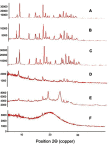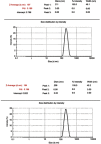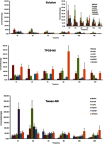The effect of surface treatment on the brain delivery of curcumin nanosuspension: in vitro and in vivo studies
- PMID: 31409999
- PMCID: PMC6649305
- DOI: 10.2147/IJN.S199624
The effect of surface treatment on the brain delivery of curcumin nanosuspension: in vitro and in vivo studies
Abstract
Background: Curcumin, a bioactive component with multiple characteristics, has been shown to have many therapeutic effects. However, there are several limitations regarding the use of curcumin such as instability, low solubility, poor bioavailability, and rapid elimination. Different approaches have been used to solve these problems. Materials and methods: In this study, surface-modified nanosuspension (NS) is investigated as a novel brain delivery system. Two different methods were used for the preparation of nanosuspensions with two different stabilizers. The surface of the nanosuspensions was coated with D-α-tocopheryl polyethylene glycol 1,000 succinate (TPGS) and Tween 80 using physical adsorption. Curcumin NSs were prepared using two different top-down techniques by high-pressure homogenizer and probe sonicator. A validated sensitive and selective high-performance liquid chromatography method using fluorescence detection was used for the determination and quantification of curcumin. Pharmacokinetics and biodistribution of curcumin NSs and solutions after intravenous administration in rats were studied. Results: Higher levels of curcumin in the brain were detected when Tween 80-coated NS was used compared with the curcumin solution and TPGS coated NS (TPGS-NS) (P-value<0.05). Absorption of ApoE and/or B by Tween 80-coated nanoparticles (NPs) from the blood were caused transferring of these NPs into the brain using receptor-mediated endocytosis. Distribution of TPGS-NS in the brain compared with the curcumin solution was higher (P-value<0.05). Higher levels of curcumin concentration in the liver, spleen, and lung were also observed with TPGS-NS. Conclusion: The results of this study indicate that the surface-coating of NSs by Tween 80 may be used to improve the biodistribution of curcumin in the brain.
Keywords: TPGS; Tween 80; biodistribution; curcumin; nanosuspensions; pharmacokinetics.
Conflict of interest statement
The authors report no conflicts of interest in this work.
Figures





 TPGS-NS,
TPGS-NS, Tween-NS,
Tween-NS,  solution). Abbreviations: TPGS, D-α-tocopheryl polyethylene glycol 1,000 succinate; NS, nanosuspension; TPGS-NS, curcumin and TPGS; Tween-NS, curcumin and Tween 80; Solution, DMA, PEG 400, and isotonic dextrose solution.
solution). Abbreviations: TPGS, D-α-tocopheryl polyethylene glycol 1,000 succinate; NS, nanosuspension; TPGS-NS, curcumin and TPGS; Tween-NS, curcumin and Tween 80; Solution, DMA, PEG 400, and isotonic dextrose solution.

Similar articles
-
Preparation, characterization, pharmacokinetics, and tissue distribution of curcumin nanosuspension with TPGS as stabilizer.Drug Dev Ind Pharm. 2010 Oct;36(10):1225-34. doi: 10.3109/03639041003695139. Drug Dev Ind Pharm. 2010. PMID: 20545506
-
Fabrication and in vitro/in vivo evaluation of amorphous andrographolide nanosuspensions stabilized by d-α-tocopheryl polyethylene glycol 1000 succinate/sodium lauryl sulfate.Int J Nanomedicine. 2017 Feb 7;12:1033-1046. doi: 10.2147/IJN.S120887. eCollection 2017. Int J Nanomedicine. 2017. PMID: 28223797 Free PMC article.
-
Fabrication of surfactant-stabilized nanosuspension of naringenin to surpass its poor physiochemical properties and low oral bioavailability.Phytomedicine. 2018 Feb 1;40:48-54. doi: 10.1016/j.phymed.2017.12.021. Epub 2017 Dec 20. Phytomedicine. 2018. PMID: 29496174
-
Nanosuspensions of poorly water soluble drugs prepared by top-down technologies.Curr Pharm Des. 2014;20(3):388-407. doi: 10.2174/13816128113199990401. Curr Pharm Des. 2014. PMID: 23651400 Review.
-
The applications of Vitamin E TPGS in drug delivery.Eur J Pharm Sci. 2013 May 13;49(2):175-86. doi: 10.1016/j.ejps.2013.02.006. Epub 2013 Feb 26. Eur J Pharm Sci. 2013. PMID: 23485439 Review.
Cited by
-
Rhynchophylline Loaded-mPEG-PLGA Nanoparticles Coated with Tween-80 for Preliminary Study in Alzheimer's Disease.Int J Nanomedicine. 2020 Feb 18;15:1149-1160. doi: 10.2147/IJN.S236922. eCollection 2020. Int J Nanomedicine. 2020. PMID: 32110013 Free PMC article.
-
Fabrication of Nanocrystals for Enhanced Distribution of a Fatty Acid Synthase Inhibitor (Orlistat) as a Promising Method to Relieve Solid Ehrlich Carcinoma-Induced Hepatic Damage in Mice.Pharmaceuticals (Basel). 2024 Jan 10;17(1):96. doi: 10.3390/ph17010096. Pharmaceuticals (Basel). 2024. PMID: 38256929 Free PMC article.
-
Review of Contemporary Self-Assembled Systems for the Controlled Delivery of Therapeutics in Medicine.Nanomaterials (Basel). 2021 Jan 21;11(2):278. doi: 10.3390/nano11020278. Nanomaterials (Basel). 2021. PMID: 33494400 Free PMC article. Review.
-
Curcumin: A Natural Warrior Against Inflammatory Liver Diseases.Nutrients. 2025 Apr 18;17(8):1373. doi: 10.3390/nu17081373. Nutrients. 2025. PMID: 40284236 Free PMC article. Review.
-
Nanosuspension Innovations: Expanding Horizons in Drug Delivery Techniques.Pharmaceutics. 2025 Jan 19;17(1):136. doi: 10.3390/pharmaceutics17010136. Pharmaceutics. 2025. PMID: 39861782 Free PMC article. Review.
References
-
- Khan, S., Imran M, Butt TT, et al. Curcumin based nanomedicines as efficient nanoplatform for treatment of cancer: new developments in reversing cancer drug resistance, rapid internalization, and improved anticancer efficacy. Trends Food Sci Technol. 2018;80:8–22. doi:10.1016/j.tifs.2018.07.026 - DOI
-
- Dong J, Tao L, Abourehab MAS, Hussain Z. Design and development of novel hyaluronate-modified nanoparticles for combo-delivery of curcumin and alendronate: fabrication, characterization, and cellular and molecular evidences of enhanced bone regeneration. Int J Biol Macromol. 2018;116:1268–1281. doi:10.1016/j.ijbiomac.2018.05.116 - DOI - PubMed
MeSH terms
Substances
LinkOut - more resources
Full Text Sources
Miscellaneous

